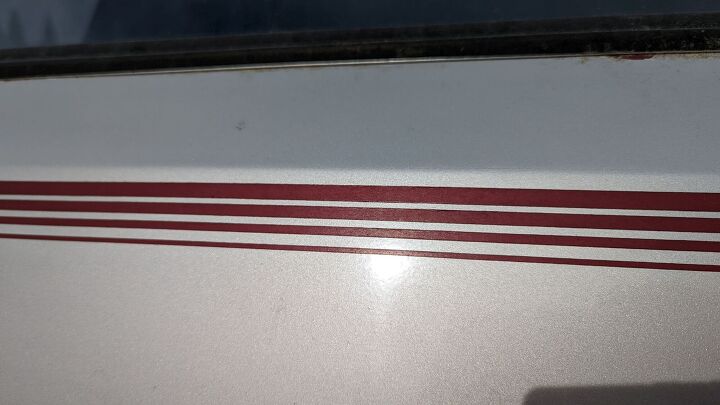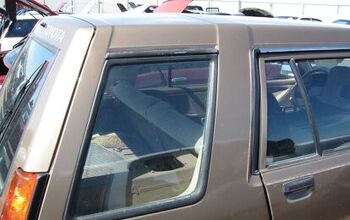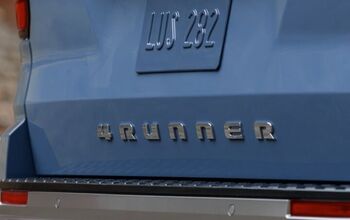Junkyard Find: 1987 Toyota Conversion Van

Chrysler revolutionized the American family-hauler world in the 1984 model year when the Plymouth Voyager and Dodge Caravan minivans first appeared. That same year, Toyota began selling Americanized versions of its LiteAce/ TownAce/ MasterAce Surf vans over here, attracting less attention but moving enough of them that I still see them during my junkyard travels. Here's an '87 that received the camper-conversion treatment, now residing in a Northern California car graveyard.
Toyota called the passenger version of this van the Van Wagon at first, but Volkswagen of America felt that name seemed awfully similar to that of the Vanagon.
Lawyers sent nastygrams back and forth, leading Toyota to change the name to the Toyota Van. This fit in well with their name for the North American-market Hilux pickup after 1973: the Toyota Truck.
When Nissan and Mitsubishi brought over their mid-engined small vans, they followed Toyota's naming lead and called them the Nissan Van and Mitsubishi Van, respectively (actually, Mitsubishi only used the Van name for the cargo version of the Delica here; the passenger version was called the Wagon). I'm disappointed that Toyota never offered a sedan called the Toyota Car.
Toyota made extra room inside this forward-control design by installing a straight-four engine, laid over on its side, beneath the front seats. This is a pushrod straight-four Y engine, rated at 90 horsepower and 120 pound-feet. To get to the engine, you have to flip up the hinged front seat mounts.
Most Americans wanted the optional automatic transmission in their Vans, and that's what this one has. I do find the occasional discarded Van with a five-speed manual.
This Van is a rear-wheel-drive version ( four-wheel-drive Vans were available) with the top LE trim level, with an MSRP of $14,598 with automatic. That's about $39,925 in 2023 dollars.
Of course, that price was before the conversion treatment.
It has the curtains, big aftermarket windows, all that good stuff.
The red-and-silver two-tone paint looks sharp with these pinstripes.
Modifiers Performance Systems was a line of 1:43 diecast toy cars, apparently.
Most of the Toyota Vans I find in these places have a lot more miles than this on their odometers. The only ones I've seen with lower odometer readings are an '84 with factory icemaker and another '87 conversion van.
The last year for the Toyota Van in the United States was 1989. It replacement, the Previa, arrived for the 1991 model year.
This looks like a job for Toyota Wonderwagon!
The panel version was the newest workhorse of the workforce.
[Images: The Author]
Become a TTAC insider. Get the latest news, features, TTAC takes, and everything else that gets to the truth about cars first by subscribing to our newsletter.

Murilee Martin is the pen name of Phil Greden, a writer who has lived in Minnesota, California, Georgia and (now) Colorado. He has toiled at copywriting, technical writing, junkmail writing, fiction writing and now automotive writing. He has owned many terrible vehicles and some good ones. He spends a great deal of time in self-service junkyards. These days, he writes for publications including Autoweek, Autoblog, Hagerty, The Truth About Cars and Capital One.
More by Murilee Martin
Latest Car Reviews
Read moreLatest Product Reviews
Read moreRecent Comments
- Sayahh I do not know how my car will respond to the trolley problem, but I will be held liable whatever it chooses to do or not do. When technology has reached Star Trek's Data's level of intelligence, I will trust it, so long as it has a moral/ethic/empathy chip/subroutine; I would not trust his brother Lore driving/controlling my car. Until then, I will drive it myself until I no longer can, at which time I will call a friend, a cab or a ride-share service.
- Daniel J Cx-5 lol. It's why we have one. I love hybrids but the engine in the RAV4 is just loud and obnoxious when it fires up.
- Oberkanone CX-5 diesel.
- Oberkanone Autonomous cars are afraid of us.
- Theflyersfan I always thought this gen XC90 could be compared to Mercedes' first-gen M-class. Everyone in every suburban family in every moderate-upper-class neighborhood got one and they were both a dumpster fire of quality. It's looking like Volvo finally worked out the quality issues, but that was a bad launch. And now I shall sound like every car site commenter over the last 25 years and say that Volvo all but killed their excellent line of wagons and replaced them with unreliable, overweight wagons on stilts just so some "I'll be famous on TikTok someday" mom won't be seen in a wagon or minivan dropping the rug rats off at school.













































Comments
Join the conversation
Wow, only made it 150k miles. So much for Toyota so-called realibility!
Murilee Martin, These Toyota Vans were absolute garbage. As the labor even basic service cost 400% as much as servicing a VW Vanagon or American minivan. A skilled Toyota tech would take about 2.5 hours just to change the air cleaner. Also they also broke often, as they overheated and warped the engine and boiled the automatic transmission...